Agriculture
What is it?
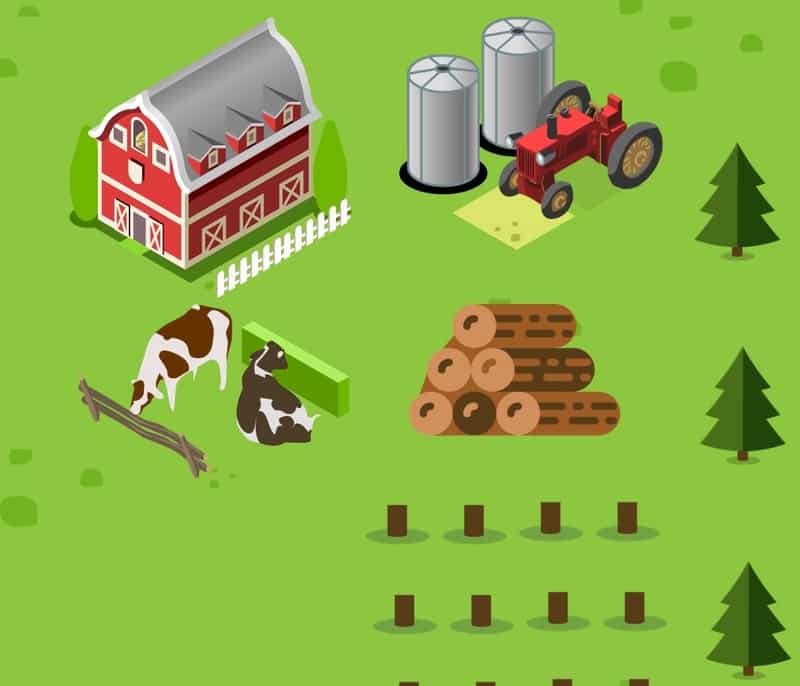
Agriculture is the practice of cultivating soil, producing crops and raising livestock. We are all familiar with traditional agricultural crops (e.g., wheat) and livestock (e.g., cattle), but agriculture also includes flower farming, medicinal plant farming and fish farming.
Agricultural products are essential for our survival. They are a large part of Alberta’s economy and are an important contribution to the global food chain.
How does agriculture impact water quality in the Bow River Basin?
The inputs that are used for agriculture (e.g., feed and fertilizers) and the wastes that are produced (e.g., manure) are all parts of the food production cycle. However, if these inputs or wastes enter the broader water system they may have negative impacts, such as eutrophication of water bodies and damage to aquatic ecosystems. Sources include:
- pesticides, fertilizers and manure entering surface water through runoff;
- contaminants entering groundwater through infiltration or leaching; and
- increased nutrient loading from animal waste and fertilizers.
Learn more about fertiliser and manure on the Nutrients fact page.
In addition to inputs and wastes, agricultural activities themselves can lead to water quality issues. Livestock drinking water from streams, for example, can damage stream banks, affecting both bank stability and vegetation. As well, soil blowing off of tilled fields can lead to increased sediment in streams. Sediment in streams can damage the eyes and gills of fish and aquatic insects; reduce sunlight in the water; and smother plants, fish eggs and invertebrates.
What can we do about it?
There are numerous Best Management Practices (BMPs) that farmers use to minimize their impact on water quality. Alberta’s Environmental Farm Plan is a voluntary, individual self-assessment tool for farmers to identify their environmental risks and create mitigation plans, which often include BMPs. Some BMPs and actions that agricultural producers and individuals can take include:
- Ensure there is a vegetated buffer zone between creeks and any areas where fertilizers are applied. This will limit the amount of nutrients entering the water via runoff.
- Ensure surface water and groundwater are not contaminated by animal waste. For example, different types of natural and synthetic liners underneath manure storage sites can protect surface water and groundwater.
- Adjust grazing intensity, keep livestock out of sensitive areas, provide alternative sources of water and shade, and promote re-vegetation of ranges, pastures, and riparian zones.
- Implement nutrient management plans that combat nutrient losses, help maintain high yields, and save fertilizer costs.
- Keep chickens, livestock and compost heaps away from any water bodies.
Where can I find more information?
A Primer on Water Quality
Agriculture and Water Quality: How land and water are linked
Clean Water is Everybody’s Business
Alberta Environmental Farm Plan
Sources:
Hofer, B. (2017, Oct. 19). Agricultural impacts on water quality in Alberta: an initial assessment. Alberta Agriculture and Forestry. Retrieved from: http://www1.agric.gov.ab.ca/$Department/deptdocs.nsf/all/irr15532
Food and Agriculture Organization of the United Nations. Forests and water quality. Retrieved from:http://www.fao.org/docrep/011/i0410e/i0410e04.pdf
http://www.fao.org/docrep/011/i0410e/i0410e04.pdf
Forest Management
What is it?

Natural Resources Canada defines sustainable forest management as a way of using and caring for forests so as to maintain their environmental, social and economic values and benefits over time.
In Alberta, timber is a valuable resource and the forestry industry is centred on harvesting trees for timber. But forests and their trees deliver extremely valuable water quality services, including slowing down water flows during rain events. Tree roots also hold soil in place, protecting soil from the crumbling and eroding effects of wind and rain.
Because forests perform valuable water quality functions, logging activities can result in negative water quality impacts. Sustainable forest management is therefore, in part, about minimizing negative impacts on water quality through the appropriate harvesting and planting of trees (forest resources).
How does forest management impact water quality in the Bow River Basin?
During a rain event, areas that have been harvested for timber usually experience higher runoff volumes traveling downstream at a faster rate. The result: higher flows in creeks and rivers and an increased potential for erosion.
Clear-cut logging and using heavy equipment to harvest trees can disturb the topsoil and undergrowth of a forest, resulting in sediment flowing into streams. Exposed soil can also release natural chemicals, nutrients and metals (e.g., mercury), which can contaminate water.
Removing trees, especially from a riparian area or wetland, may impair that area’s ability to hold sediment in place, and can capture and remove some sediment and contaminants already in the water. When these functions are impaired, water quality decreases.
Like the agriculture sector, the forestry sector uses Best Management Practices (BMPs) that are designed to reduce negative water quality impacts.
What can we do about it?
Reducing the damage to the soil, regenerating the forest quickly, and not harvesting on slopes or near water bodies are all good forest management practices.
Some of the most important forest management BMPs include selection of access road locations to reduce potential for erosion and soil disturbance, implementing a well-designed road drainage system that reduces erosion and sediment delivery to streams, installation and maintenance of silt screens or fences, and conducting selective harvesting.
Where can I find more information?
Alberta Government Forest Management Facts and Statistics information page
Sources:
Food and Agriculture Organization of the United Nations. Forests and water quality. Retrieved from: http://www.fao.org/docrep/011/i0410e/i0410e04.pdf
Holaday, S., Wagner, C. (2010). Field manual for loggers, landowners, and land managers. Wisconsin Department of Natural Resources. Retrieved from: http://dnr.wi.gov/topic/forestmanagement/documents/pub/fr-093.pdf
Pike, R., Feller, M., Stednick, J., Rieberger, K., Carver, M. Water quality and forest management. Retrieved from: https://www.for.gov.bc.ca/hfd/pubs/docs/lmh/Lmh66/Lmh66_ch12.pdf
Government of Canada. (2016, July 1). Water pollution: erosion and sedimentation. Retrieved from: https://www.ec.gc.ca/eau-water/default.asp?lang=En&n=32121A74-1#reason4
Regional Aquatics Monitoring Program. Potential effects of forestry on aquatic ecosystems. Retrieved from: http://www.ramp-alberta.org/resources/forestry/potential+effects.aspx
McLellan, B. (2016, Oct. 24). Impact of forest harvest. Alberta Agriculture and Forestry. Retrieved from: http://www1.agric.gov.ab.ca/$department/deptdocs.nsf/all/apa3317 PUBLISHED: 04 DECEMBER 2017
Industry
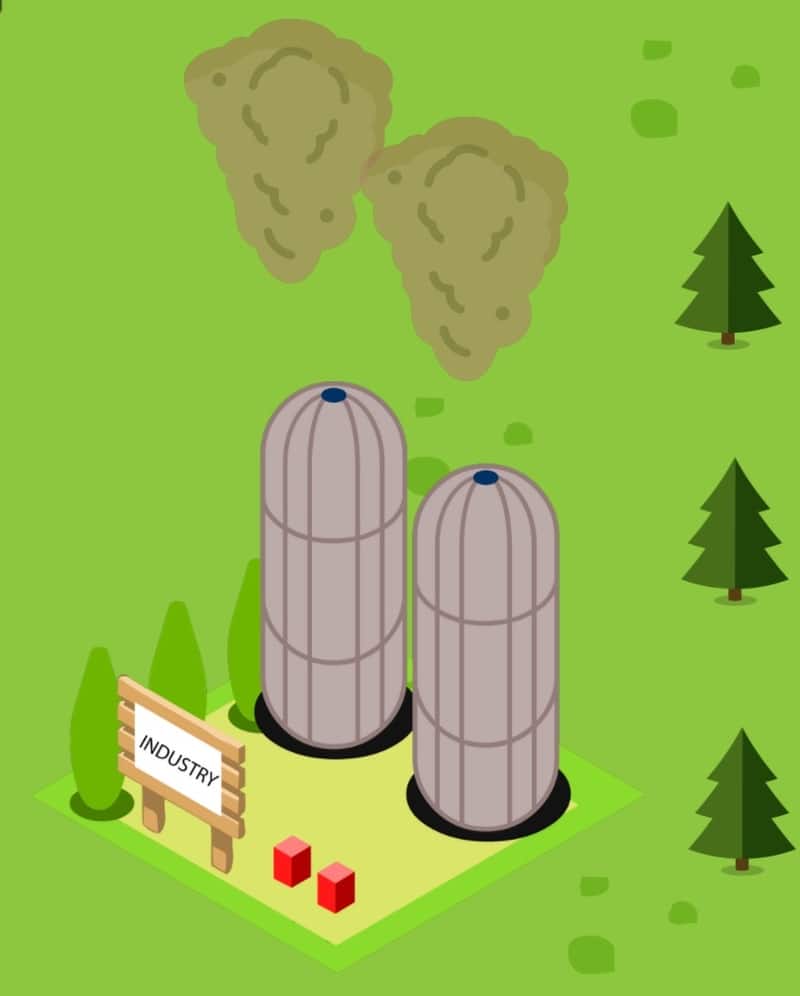
What is it?
Industry is a general term for the collection of businesses that manufacture, produce, or process various goods and services within an economy. There are numerous industries and commercial activities in the Bow River Basin, including manufacturing, transportation, tourism, energy production, construction, retail and wholesale, and resource extraction.
How does industry impact water quality in the Bow River Basin?
Industries rely on water for many processes and some industries impact water quality more than others. Water is used as a cleaner, a solvent, a coolant, and a lubricant. If water becomes a by-product of any of these uses (i.e., industrial effluent or wastewater) and is directly deposited into a water body, water quality can be directly impacted.
It is interesting to note that most industrial wastewater has a higher temperature than natural source water (water in lakes or rivers). When wastewater is discharged, it can increase the temperature of the source water. Some aquatic species (such as cold water fish) are sensitive to changes in temperature and may experience adverse effects at, or downstream of, the discharge site.
In addition to these direct impacts, water quality can also be indirectly impacted by the release of industrial materials into the air, which may eventually fall to the ground and be carried into the waterways.
Industrial sites themselves can also impact water quality. Water pollution can be an issue at abandoned oil or gas wells, or closed-down chemical plants. Over time, waste storage facilities or underground infrastructure may become damaged and contaminants can leak into the surface or groundwater system. Contamination can also occur due to spills from pipelines, railways, or storage facilities such tailings ponds.
Common sources of water pollution from industry include:
- leakage due to poor maintenance or construction
- inappropriate disposal practices
- poor handling and storage procedures
- accidental spills
- plant/facility fires, explosions or other accidents
What can we do about it?
Report instances of deleterious substances entering storm drains (contact your local municipality) or waterways by calling the 24 hr Energy & Environmental Response Line 1-800-222-6514 within Alberta.
Routine monitoring of water bodies downstream of industrial activities, current and closed, can help identify if contaminants are leaking.
Government of Canada Pollution Prevention Tools and Tips
Where can I find more information?
Alberta Environment and Parks regulates the amount and release of industrial effluent to protect the environment and human health. Policy guidance for industrial release limts can be found here.
The CCME Canada-wide strategy for the Management of Municipal Wastewater Effluent regulates management of wastewater.
CCME Canadian Environmental Guidelines
Sources:
Alberta Government. (2013). Tourism development guide. Retrieved from: https://www.albertacanada.com/files/albertacanada/CT-Tourism-Dev-Guide.pdf
Bow River Basin Council. (2005). A report on the state of the Bow River Basin. Retrieved from: http://aep.alberta.ca/water/programs-and-services/water-for-life/partnerships/watershed-planning-and-advisory-councils/documents/BowRiverBasinStateWatershed-May2005.pdf
Government of Canada. (2016, July 1). Water pollution: erosion and sedimentation. Retrieved from: https://www.ec.gc.ca/eau-water/default.asp?lang=En&n=32121A74-1
Alberta Energy. (2017). Minerals. Retrieved from: http://www.energy.alberta.ca/OurBusiness/minerals.asp
Bunch, K. (2017, Aug. 4). Low probability, high impact: radionuclides, nuclear waste, and the Great Lakes. Retrieved from: http://ijc.org/greatlakesconnection/en/2017/08/low-probability-high-impact-radionuclides-nuclear-waste-great-lakes/?utm_content=buffer8866d&utm_medium=social&utm_source=linkedin.com&utm_campaign=buffer
Hussain, M., Prasad Rao, T. (2013). Effect of industrial effluents on surface water quality – a case study of Patancheru, Andhra Pradesh, India. Current World Environment 8(3), 445-454. PUBLISHED: 18 DECEMBER 2017
Irrigation
What is it?
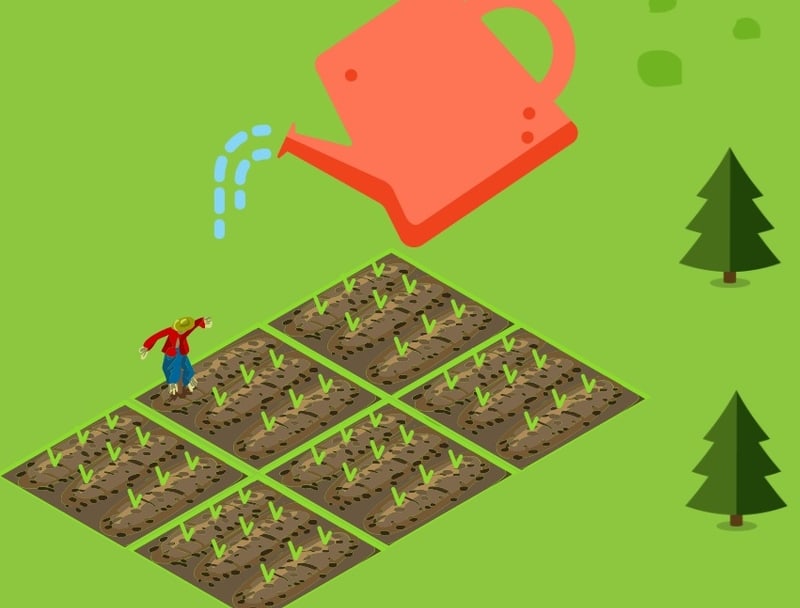
Irrigation is the method in which a controlled amount of water is supplied to plants at regular intervals for agriculture. It is used to assist in the growing of agricultural crops, maintenance of landscapes, and the re-vegetation of disturbed soils in dry areas or during periods of inadequate rainfall.
Irrigation has a long and significant history in the economy of the Bow River Basin, with the Western and Eastern irrigation districts dating back to the 1930s and 40s, and the Bow River Irrigation District since 1950. Agricultural production in Alberta is a significant part of the total Canadian agricultural production, much of which is facilitated by irrigation.
How does irrigation impact water quality in the Bow River Basin?
High-volume water users, including irrigation districts, divert water away from the mainstem of the river. This changes the volume of water in the river, which impacts the capacity of the river to dilute and/or assimilate substances (e.g., sediment, contaminants, nutrients). To read more about dilution and water quality click here.
Increased salt concentrations can be caused by seepage from irrigation canals and return flows from irrigated lands. High salinity can increase water treatment costs, corrode plumbing and reduce crop yields. Contaminated groundwater from percolation of irrigation water or seepage from irrigation systems can both recharge and negatively impact water quality of rivers. For example, the Colorado River receives 454 000 kg of salt annually.
Elevated concentrations of selenium in irrigation drainage water are linked to waterfowl deaths, deformities and reproductive failures.
What can we do about it?
The irrigation systems in Alberta are continually being updated to be more efficient with water use; improved efficiency of individual farm and ranch irrigation systems can also reduce water demand and runoff.
Much of the water demand in irrigation is determined by the weather and by the type of crop that is being grown. For the most part we cannot change the weather, but acting to limit climate change may help improve water quality and quantity in the long run.
Where can I find more information?
Sources:
Thygesen, L. (2002, March 4). A primer on water quality: impact of crop production practices on water quality. Alberta Agriculture and Forestry. http://www1.agric.gov.ab.ca/$department/deptdocs.nsf/all/wat3348 PUBLISHED: 18 DECEMBER 2017
Outdoor Recreation
What is it?

Outdoor recreational activities include boating, camping, fishing, hiking, biking, off-highway vehicle use, horseback riding, swimming and tubing. Such activities are valuable for many reasons. They can improve our physical and mental health, and inspire us to appreciate and value our natural ecosystems. They can also bring economic benefits to communities. Businesses, like rafting companies, can create jobs and increase tourism. Perhaps most importantly, however, recreational activities are valuable because they allow people to enjoy and appreciate the Bow River Basin’s generally high quality of water.
How does outdoor recreation influence water quality in the Bow River Basin?
Outdoor recreation affects sediment and can increase erosion:
- When recreationalists (e.g., hikers, bikers, horseback riders and motorized vehicle users) do not use a bridge to cross waterways (rivers or creeks), they can disturb sediment and cause it to be carried downstream. If the river or creek has an exposed stream bank, the amount of disturbed sediment can be even higher.
- Frequently used hillside trails are at a higher risk of damage, including soil disturbance or loss of vegetation. When this damage occurs, erosion (from rain or snowmelt) increases, contributing to higher levels of sediment in waterways.
- Vehicles with large tire treads can destroy vegetation and churn up the soil, resulting in increased erosion from rain or snowmelt.
- Increased sediment in waterways causes difficulties for water treatment facilities.
- Increased sediment in waterways affects the habitat of fish and aquatic insects.
Recreation increases the types and amounts of substances found in water:
- Sunscreen and insect repellent from swimmers can wash off into the water.
- Gasoline, motor oil, and other vehicular fluids can spill or leak into waterways.
- Improperly managed sanitary waste and garbage can end up in the water.
Recreation can contribute to the problem of aquatic invasive species:
- Boats or fishing gear that are used in multiple bodies of water can transport aquatic invasive species, thereby changing ecosystems and impacting water quality.
What can we do about it?
Spending time outdoors is one of the best ways to stay mentally and physically healthy, and to appreciate the amazing ecological services our natural systems provide. By following these tips, you will help protect these services and ensure the outdoors can be enjoyed for generations to come:
- Stay on designated trails while you are hiking, biking, or riding. Designated trails are designed with bridges, walkways and sufficient space to limit impacts on water.
- Avoid driving vehicles through wetlands or waterways.
- To avoid accidentally transporting invasive species, ensure your boat, trailer, off-highway vehicle, fishing gear and hiking boots are always cleaned, allowing them to dry completely between uses in different water bodies. Fishing gear and boots can be put in a freezer to kill many attached invasive species.
- Utilize designated watercraft inspection stations along highways when returning from boating trips.
- Do not dump human waste into or near water or ice when boating, camping, recreating, or ice-fishing.
- Avoid spilling gas, oil, paint, varnish, or other chemicals when fueling or maintaining your boat or off-highway vehicle.
- Use biodegradable soap and dispose of washing water properly (in designated areas and away from lakes, rivers or creeks).
Where can I find more information?
Limiting Impact of Recreation on Water Quality
Water Quality Basics – What you can do
Sources:
Jackson, L. (2015). Human impacts on water quantity and quality, the implications for socio-economic processes, and policy development in the South Saskatchewan River Basin. Retrieved from: http://www.cwn-rce.ca/project-library/project/human-impacts-on-water-quantity-and-quality-the-implications-for-socio-economic-processes-and-policy-development-in-the-south-saskatchewan-river-basin?u=keyword%3Dmark%20lewis
Alberta Environment and Parks. (2017, May 11). Recreation on public land – motorized. Retrieved from: http://aep.alberta.ca/recreation-public-use/recreation-on-public-land/motorized.aspx
Province of Alberta. (2017). Traffic Safety Act – Off-highway Vehicle Regulation. Retrieved from: http://www.qp.alberta.ca/documents/regs/2002_319.pdf
Province of Alberta. (2017, May 15). Revised Statutes of Alberta 2000 Chapter T-6. http://www.qp.alberta.ca/documents/Acts/t06.pdf
Alberta Off-Highway Vehicle Association. http://aohva.com/respect/ PUBLISHED: 04 DECEMBER 2017
Stormwater
What is it?

Stormwater is commonly understood as runoff, from rainfall or snowmelt events, that flows over land and constructed surfaces (e.g., roofs, parking lots and roads).
Stormwater flows into storm drains (e.g., grates on the sides of streets), other stormwater management infrastructure, or directly into waterways.
How does stormwater influence water quality in the Bow River Basin?
As water flows over land and constructed surfaces, it picks up pollutants, sediment and debris, including motor oil, road salt, sand, fertilizer and excrement.
The Government of Alberta and most municipalities have standards and guidelines in place to help ensure contaminants in stormwater are removed to an appropriate level prior to the water being discharged into a receiving river or lake.
To meet these standards and guidelines, urban areas are designed to include stormwater management features. Common design features include storm drains and pipes, stormwater ponds and wetlands, and other types of green infrastructure (e.g., bioswales, rain gardens and permeable pavement), which drain stormwater and slow runoff, helping to remove some of the contaminants.
What can we do about it?
Do not pour motor oil, paint, or other chemicals down any kind of drain (whether storm drains or sinks in your home). Dedicated hazardous waste facilities exist for materials like these.
Garbage, household greywater (residual water from washing yourself or your dishes/laundry) and sewage should not be put down storm drains.
Use care when applying fertilizer to your outdoor spaces. Consider using a drop spreader to keep fertilizer off driveways, sidewalks and roads, as this reduces how much fertilizer ends up in stormwater.
Where you can, remove impervious surfaces. In some places, impervious concrete and asphalt can be replaced with porous asphalt or permeable pavement. It may also be possible to change the design to reduce the area of paved surface.
Use Low Impact Development (LID) techniques in urban areas, as they can make a big difference to stormwater quality and quantity, as well as groundwater recharge.
Where can I find more information?
Alberta Low Impact Development Partnership
Alberta Government Stormwater Management Guidelines
Urban Runoff – Low Impact Development
City of Calgary History of Stormwater page
Sources:
Canada Mortgage and Housing Corporation. (2017). Alternative stormwater management practices for residential projects. Retrieved from: https://www.cmhc-schl.gc.ca/en/inpr/su/waho/waho_006.cfm PUBLISHED: 18 DECEMBER 2017
Wastewater Treatment Plant
What are they?
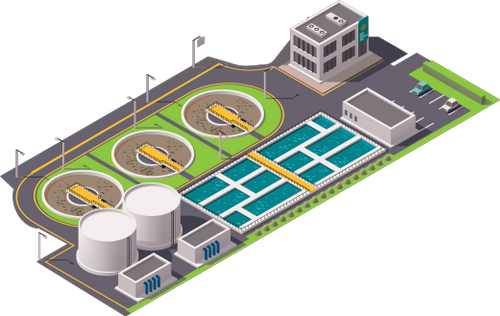
Wastewater treatment plants convert effluent (water that has been used for some industrial or public purpose) into water that can be either returned to the water cycle with minimal environmental issues or reused.
How do wastewater treatment plants impact water quality in the Bow River Basin?
Wastewater treatment plants remove large amounts of contaminants and organic matter from the wastewater stream, thereby improving water quality. However, the effluent from wastewater treatment plants can still have higher concentrations of nutrients and other contaminants than natural surface water. Therefore wastewater treatment plants are considered a “point source” of pollution in the environment.
The City of Calgary online tour provides an example of the processes undertaken at a wastewater treatment plant. When wastewater reaches a plant, it passes through screens that remove large materials such as plastic bags, toilet paper, paper towels, sticks and tennis balls. It then passes through a series of tanks where solids settle, and oils and grease are skimmed off the top. Effluent is then digested by microorganisms that remove much of the nutrients and organic material. Water is then clarified by settling, and finally, filtered and disinfected prior to being released into the river.
There are numerous contaminants in the wastewater stream which are not completely removed by wastewater treatment processes. Many of these contaminants are from everyday products (e.g., medicines, household materials) and their downstream impacts are not fully understood. Some of the contaminants that are not removed by the wastewater treatment process can impact aquatic species. More information can be found on the fact page for Emerging Contaminants.
What can we do about it?
The smooth operation and maintenance of our wastewater collection systems and treatment facilities depends, in large part, on what we collectively put down our drains. Grease, disposable wipes and hygiene products can cause local and systemic issues in collection systems and treatment facilities. Issues can include pipe clogging and disruption to the biological treatment processes typically at work in treatment facilities. This increases costs and ultimately results in increases of taxes or utility rates for end users.
Individuals can help to reduce the level of nutrients, contaminants and debris in our wastewater collection and treatment systems by:
- Taking all unused and expired medication to their local pharmacy for safe disposal.
- Avoiding flushing dental floss, bandages, wipes and hygiene products down the toilet.
- Avoiding putting grease or oil (and fatty foods like butter and salad dressing) down the sink.
Household hazardous waste must be disposed of properly, and not allowed to leak or spill. Hazardous wastes include bleach and ammonia, batteries, latex and oil-based paints, lacquers and varnishes, oven cleaners, and petroleum-based products such as motor oil and gasoline. Hazardous wastes should be dropped off at a household hazardous waste drop-off location.
Alberta’s provincial standards are more stringent than the national performance standards. The Government of Alberta has taken numerous steps to ensure the protection of surface waters, including the development of the surface water quality guidelines, and a requirement for a receiving waters assessment. For example, The City of Calgary’s Total Loading Management Plan (TLMP) is required by Alberta Environment and Parks for The City to operate their wastewater treatment plants.
Another potential for reducing the amount of effluent that is returned to the river is the re-use of the effluent for various purposes, such as irrigation. The Government of Alberta has Guidelines for Municipal Wastewater Irrigation that outline specific water quality and other requirements to undertake this activity. Alberta Environment and Parks is also developing a Water Reuse and Stormwater Use Policy that will outline other ways that treated wastewater can be used to avoid discharge into our natural waterways.
Where can I find more information?
What not to flush down sinks, drains and toilets
City of Calgary Wastewater Treatment Plant online tour
Sources:
Alberta Environment and Parks. (2017, May 9). Bow River Phosphorus Management Plan. Retrieved from: http://aep.alberta.ca/water/education-guidelines/surface-water-quality-guidelines-and-objectives.aspx
Arnusch, S. (2014, Aug. 27). Blue Ribbon Bow: Fishing for Trout in the City. http://www.avenuecalgary.com/Things-to-Do/Blue-Ribbon-Bow-Fishing-For-Trout-in-the-City/
Alberta Environment and Parks. (2017, April 25). Surface water quality guidelines and objectives. Retrieved from: http://aep.alberta.ca/land/cumulative-effects/regional-planning/south-saskatchewan/bow-river-phosphorus-management-plan.aspx PUBLISHED: 18 DECEMBER 2017
Water Treatment Plants
What are they?
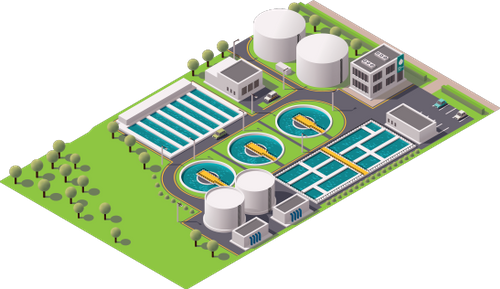
Water treatment is a process that alters the chemical and/or physical properties of source water so that it can be used for a specific purpose. Water is treated before it is used for drinking water, industrial processes, irrigation, water recreation, or before being safely returned to the environment. Water treatment plants are facilities that remove harmful or undesirable substances from the source water, producing water that is fit for its specific purpose.
Federal and provincial health-related standards and guidelines outline the requirements for water that is delivered to your home. All potable water in Alberta must meet the Guidelines for Canadian Drinking Water Quality, published by Health Canada. These guidelines can be found here.
How do water treatment plants impact water quality in the Bow River Basin?
Water treatment plants remove contaminants from source water (e.g., the Bow River) through the addition of certain substances for disinfection and flocculation (settling).
Disinfection may be achieved using chlorine, ultraviolet light, chlorine dioxide, or ozone. Disinfection is required at drinking water facilities to ensure a required level of pathogen reduction is achieved. See the fact sheet on Microorganisms.
The Bearspaw Water Treatment Plant is a pre-treatment facility that uses a process known as “flocculation” to capture and remove silt, debris and micro-organisms from the raw water supply. Chlorine is added to the clarified water, which then rests for enough time to disinfect the drinking water by killing microorganisms and viruses that can cause disease. The final filtration step removes any remaining silt, debris and microorganisms from the water with a number of large filtration beds made of crushed coal and crushed sand.
What can we do about it?
Protecting upstream ecosystems is very important in maintaining good source water quality. Good source water quality means fewer substances (e.g., chlorine) are needed to make the water safe. This strategy is called “source water protection.” Source water protection initiatives and regulations are implemented at provincial, municipal, and local levels.
Where can I find more information?
The Bearspaw Water Treatment Plant online tour
Sources:
City of Calgary. (2017). Water taste, odour, and appearance. Retrieved from: http://www.calgary.ca/UEP/Water/Pages/Drinking-water/Water-quality/Water-Taste-Odour-Appearance.aspx
Reid, D. (2012, April). Standards for Municipal Waterworks (Part 1 of 5). Retrieved from: http://aep.alberta.ca/water/programs-and-services/drinking-water/legislation/documents/Part1-StandardsMunicipalWaterworks-2012.pdf
Alberta Environment and Parks (2016, Aug. 18). Groundwater. Retrieved from: http://aep.alberta.ca/water/programs-and-services/groundwater/default.aspx
Alberta Environment and Parks (2016, July 21). Drinking water. Retrieved from:http://aep.alberta.ca/water/programs-and-services/drinking-water/default.aspx
Battle River Watershed Alliance. (2014, September). Watershed Management Plan: Water Quality Component, Source Water Protection: Policy Advice. Retrieved from: http://aep.alberta.ca/water/programs-and-services/water-for-life/partnerships/watershed-planning-and-advisory-councils/documents/BattleRiverSourceWaterProtection-Sep2014.pdf PUBLISHED: 04 DECEMBER 2017
Wetlands
What are they?

A wetland is a type of ecosystem that has both aquatic and terrestrial properties. There are many different types of wetlands. Some wetlands are covered by water for all or part of the year, while others do not appear wet but are sporadically or seasonally saturated and have a water table close to the soil surface.
The characteristics of a wetland are determined by soil type, topography, climate, available nutrients, the types of plants and animals present, and water chemistry. The plants and animals that live in wetlands are adapted to their unique conditions, forming biological communities that are different from the surrounding area.
Wetlands are among the most productive, complex and diverse habitats on Earth. They provide valuable ecosystem services, including recharging groundwater, sequestering carbon from the atmosphere, providing nursery areas for many species, and reducing the effects of drought.
How do wetlands influence water quality in the Bow River Basin?
Wetlands have positive effects on water quality. They can:
- retain and remove nitrogen and phosphorus,
- absorb contaminants, and
- trap sediment from water and slow down flow rates to allow settling and reduce erosion.
Because of these positive effects, constructed wetlands (wetlands built to mimic natural wetland processes) are often used for stormwater or other types of wastewater treatment. The type of treatment required will influence the type of wetland that is constructed. See our fact page on Stormwater for more information.
What can we do?
Wetlands improve water quality and provide valuable ecosystem services. We must therefore protect and improve the function of existing wetlands in Alberta. We must also construct additional wetlands for stormwater and other wastewater treatment.
Where can I find more information?
Facts About Water in Alberta – Benefits of Wetlands (pg. 19)
The role of wetlands in reducing flood damage
Treatment Wetlands Second Edition
Sources:
U.S. Environmental Protection Agency. (2017, Aug. 18). Wetlands Protection and Restoration. Retrieved from: https://www.epa.gov/wetlands
U.S. Environmental Protection Agency. (2015). Connectivity of streams and wetlands to downstream waters: A review and synthesis of the scientific evidence. EPA/600/R-14/475F, United States Environmental Protection Agency, Washington, DC. 388 p. PUBLISHED: 18 DECEMBER 2017
Wildfires
What are they?

Wildfires are fires, started by natural causes or human activities, that burn large areas of vegetated land.
How do wildfires impact water quality in the Bow River Basin?
Lingering firefighting chemicals left in the soil after a fire can degrade water quality.
Following a wildfire, large amounts of sediment and organic matter (e.g., ash and dead plant matter) may be introduced into waterways. Soil no longer held in place by vegetation and tree roots also washes into streams.
When a fire removes all vegetation and trees from a large area, rainfall and snowmelt flows off the land at a much quicker rate. This causes stream bank erosion and increases sediment loading, and can sometimes result in flooding.
The heat from a fire can damage the soil structure, making it easier for erosion to occur.
When a fire burns vegetation, and heavy metals and nutrients are exposed and washed into streams, the pH and other chemical properties of the water can be changed.
What can we do about it?
Be very careful with campfires and backyard fires to ensure they do not spread.
During a fire-ban, respect all regulations.
Make sure to report any signs of wildfires you see.
Obey area-specific signs posted by local fire and rescue operations.
Where can I find more information?
How wildfires impact a watershed
Blog post “When Wildfires threaten our drinking water”
Sources:
Meixner, T. (2004, October). Wildfire impacts on water quality. Retrieved from: http://swhydro.arizona.edu/archive/V3_N5/feature7.pdf
Emelko, M., Ho Sham, C. (2014). Wildfire impacts on water supplies and the potential for mitigation: workshop report. Retrieved from: http://www.cwn-rce.ca/assets/resources/pdf/Wildfire-Impacts-on-Water-Supplies-and-the-Potential-for-Mitigation_Workshop-Report.pdf
Cecco, L. (2016, June 17). Wildfires can have major impact on water quality. Globe and Mail. Retrieved from: https://beta.theglobeandmail.com/news/alberta/wildfires-have-major-impact-on-waterquality/article30512613/?ref=http://www.theglobeandmail.com&
Waskom, R., Kallenberger, B., Bauder, T. (2017). Addressing the impacts of wildfire on water resources. Retrieved from: http://extension.colostate.edu/topic-areas/natural-resources/addressing-the-impacts-of-wildfire-on-water-resources-6-706/
Neary, D., Ryan, K., DeBano, L. (2008). Wildland fire in ecosystems, effects of fire on soil and water. Retrieved from: https://www.fs.fed.us/rm/pubs_journals/2015/rmrs_2015_aregai_t001.pdf
Tecle, A., Neary, D. (2015, July 14). Water quality impacts of forest fires. Journal of Pollution Effects and Control. 3:140.
